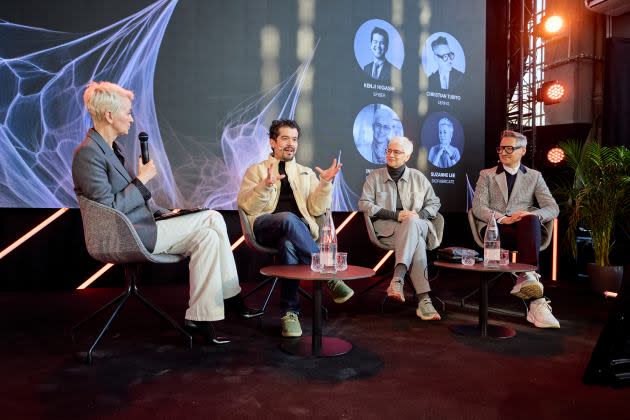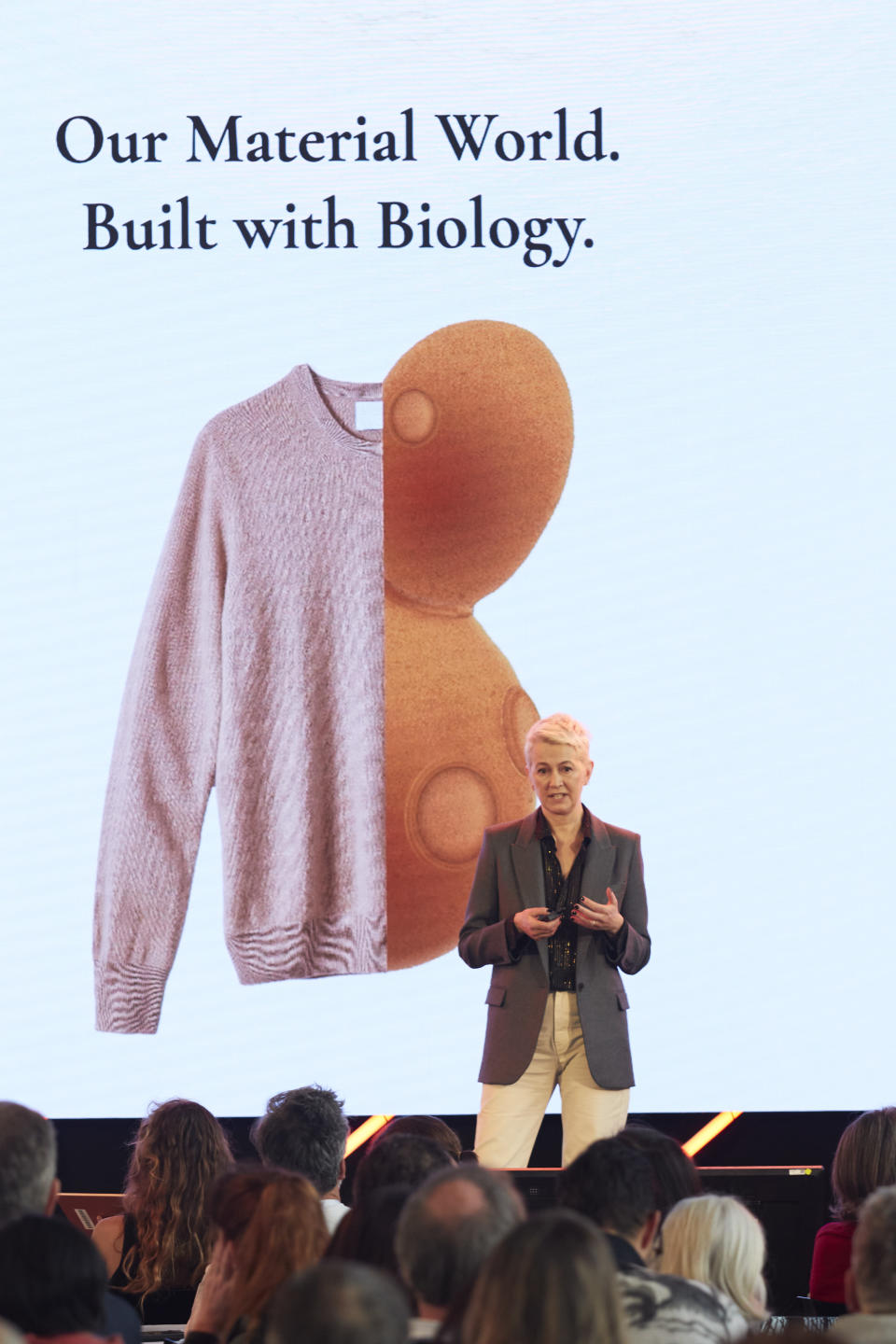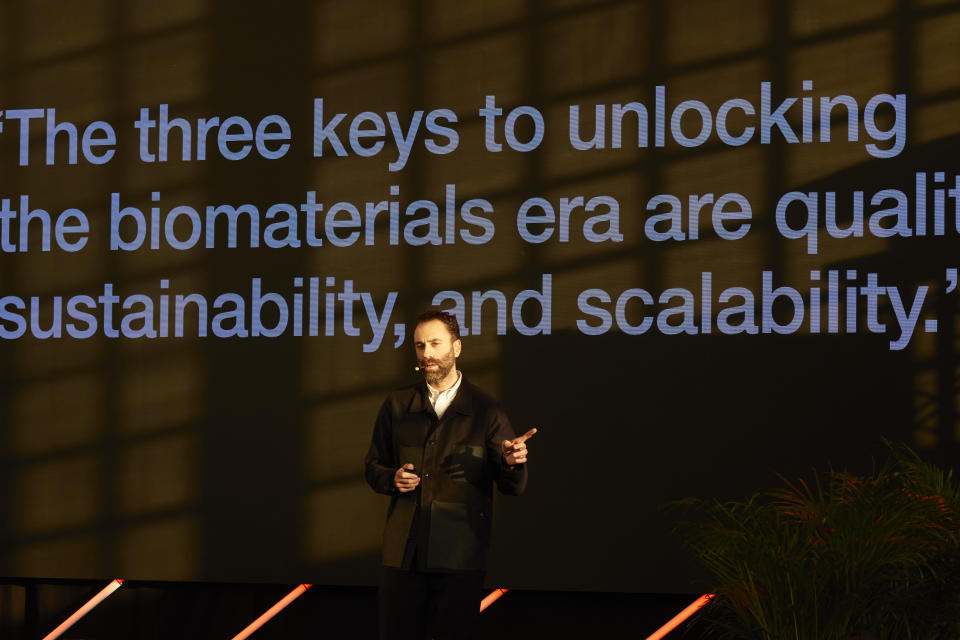Innovation, Investment: What’s Next for New Materials at Biofabricate

PARIS — A decade after its first gathering, the Biofabricate convention brought corn, mushrooms and shrimp to Paris — they are some of the unconventional building blocks of the showcased next-generation materials.
Established brands also unveiled big moves, while investors discussed what the market needs.
More from WWD
With Paris becoming more of a hub for innovation due in part both to it being the base for leading luxury brands (and their deep pockets), and the European Union’s legislative focus on the fashion industry, Biofabricate chief executive officer Suzanne Lee felt the time was right to hold the event in France.
“The EU is driving global regulations. We wanted to educate startups, certainly some from North America, about how if you’re not compliant with what’s happening in Europe, you’re really going to kill your business before you even start,” Lee said.
She emphasized that the event is not a trade show and instead meant to demonstrate early-stage innovations. “Right now, they need investment, they need brand partners who can help them further develop the technology,” she said. While next-gen materials were often relegated to one-off or “crunchy” collections, the luxury houses are now on board.
“[Small brands] unfortunately lack the resources to make investments or to understand that maybe it’s a three-year journey before they’ll have access to [the material],” she said. “The big brands can wait and they have internal teams who work with the innovators to get it to the level that it needs to be to be truly robust for the market.”
Lee noted that while athletic brands such as Adidas and Nike were initially frontrunners in investing, they have pulled back as their performance has struggled in recent quarters. “They were more bullish about it. They were doing more experimentation. Right now it’s not looking so good.”
Luxury can step up to the plate. Kering came on board as a Biofabricate sponsor, and brought teams from across brands and diverse departments, including design, supply chain and investment.

Designers’ New Approach, Consumer Mindset Shifts
Both the consumer and creator mindset is shifting, said multiple participants. Designers are embracing alternative materials in new ways. A decade ago it was all about mimicking leather and creating lab-grown skin from animal cells. Now next-gen companies are working with different input materials — the above-mentioned corn or shrimp being just a couple — and creatives are playing up their odd aspects.
Balenciaga was one example of this new perspective. Both its Ephea coat from the fall 2022 collection and its Lunaform coat from spring 2024 were on display. The coats are made from different mushroom-based textiles, and accent the unique textures of each textile.
“These don’t look like products you’ve ever seen from an animal, or from a petrochemical, they’re different. They’re not trying to cover up the natural quality, they’re actually embracing it,” Lee said.
Kering’s 11 million euro investment in Sqim is not only a vote of confidence in the startup, but a new way to build a long-term collaborative partnership. “[Kering] is saying, we need for you to get the material where it needs to be,” she said.
It’s a future-poof move for the luxury company. They won’t stop producing leather goods from animals, at least for the time being, but are reading the tea leaves on shifting consumer sentiment from issue-driven Gen Z.
Much of the buzz at the event was about this shift, with many participants citing anecdotes of young children or relatives being selective about the environmental credentials of their purchases.
The brands will also have to demonstrate that next-gen materials have long-term durability and value, especially as young consumers are starting to make purchases with resale in mind.
While many participants were talking about scalability before any material seems viable to the fashion industry, Matereal CEO Jacqueline Amable made the counterargument that fashion is in the perfect position do small batch collections or special capsules to test new materials.
She also noted that as demographics shift, consumers are actively looking for alternatives and the fashion industry needs to step up with solutions.
Ganni CEO Nicolaj Reffstrup discussed his brand’s commitment to stop using animal-derived leather in its products. It has hit the bottom line, but brands have to be willing to make these short-term sacrifices, he said.
Looking at Ganni’s best-selling cowboy boot, there were two colorways that could not be replicated with new materials. They had to stop selling the style, which resulted in a loss of about 2.5 million euros in sales, he said.
“It’s more a moral obligation than it’s anything else at this stage, because there’s no immediate ROI,” Reffstrup said.
He noted that any market advantage from being an early adopter of ethical materials will erode quickly as more brands jump on board. However, he said he disagreed with the multiple panelists saying consumers are driving change.
“I don’t see a lot of consumer action even today, on a broader scale,” he said. “We live inside a kind of bubble-ish life and think of what our peers are interested in, but 99 percent of all people aren’t really.”
Reffstrup added that when speaking with buyers who are taking great care to work with sustainable brands, they are also careful not to position things as “sustainable” to consumers because now that word is conflated with “greenwashing.”
“[Consumers] don’t want to hear about it. They just want great storytelling, something that’s funny, something that looks cool,” he said.
His Look Up Ventures arm is investing in deep tech, hardware and building supply chains, including things like modified crops that don’t have an immediate benefit for the fashion industry but are long-term climate adaptive solutions.

New Partnerships, Investment Funds and Launches
MycoWorks unveiled its new partnership with French furniture company Ligne Roset, which has committed to acquiring a “significant portion” of the company’s production capacity of its Reishi material. MycoWorks opened its full-scale factory in South Carolina last October, and the first big shipment of its mycelium material was shipped to its European partner tanneries earlier this month.
Ligne Roset will incorporate Reishi into its product lines. MycoWorks CEO Matt Scullin showed off a prototype of one of the brand’s signature curved Togo chairs.
MycoWorks is “totally focused on the luxury industry” right now, said Scullin. With the new plant online, the company has automated production, reducing grow time and cost. More factories will be coming, with an eye toward the broader consumer market.
“It’s a step on our way to addressing the mass market opportunity with the plants that come next. We have mass market partners who we’re working with to build future plants,” he said. “The next plants will be cost effective for them.”
Parley for the Oceans is famous for using reclaimed ocean plastic to create new materials, and has been behind a successful Dior collaboration, as well as one with Adidas. Founder and CEO Cyrill Gutsch said the company has quietly been investing in materials for a while, and will begin to increase that activity under the banner Parley Future Material.
“We’re entering the second chapter,” he said. “We don’t think that the current form of investment company and the way investors are engaging with the companies, we think that’s wrong,” he said. “Often because they have too much influence on the wrong sides, they’re pressing too fast on commercialization. They want to quickly get money back, and they’re often really driven by shorter terms, which is a five- to seven-year window, which means they kind of push very quickly on getting a company to the level that the value increases. We believe that we need to push companies to become a true solution.”
The value of the fund or number of investments was not disclosed.
The company’s first investment has been in Bananatex. Gutsch took to the stage to show off the first jacket from Dior menswear creative director Kim Jones in the new fabric. Jones will begin to incorporate Bananatex into the collections later this year.
Parley opened an office in Paris earlier this month, with former Dior executive Rémi Macario at the helm, in order to work more closely with luxury brands.
Tom Ford Plastic Innovation Prize winner Sway officially launched its TPSea at the conference, which is a building block for flexible plastic packaging that can operate in existing manufacturing infrastructure, and can be used to replace polybags and retail shopping bags. The cleantech company will launch its compostable Thermoplastic Seaweed Film in February, CEO Julia Marsh said.
Spiber, Kering Materials Innovation Lab, Eileen Fisher and Johnstons of Elgin also revealed their new partnership covering research and development on recyclable dyes and chemical treatments.
Elsewhere, there were a few rebrands, with Bucha Bio debuting as Rheom as it moves into injectable bio plastics, and BioPuff alternative down maker Saltyco emerging as Ponda. Both said the name changes were to better reflect advances in a wider range of offerings.
Investment to Bounce Back This Year
“The market is thinking beyond short term greenwashing,” said MycoWorks’ Scullin. “In 2023 this field transitioned from hype to reality.”
One participant said that, after Bolt Threads halted production of its Mylo material last July, the industry is now eyeing Mycoworks as a bellwether. “We need a big win for the industry,” he said. The manufacturer compared it to the vegan food market, noting that it wasn’t until Beyond Meat’s $3.8 billion IPO that money poured into the sector.
The industry panel on finance, featuring Kering’s ventures and innovation director Benjamin Bouygues; Sofinnova Partners partner Mary McCarthy; Novo Holdings partner Marcus Remmers, and Barclays’ sustainable and impact banking managing director Bryan Wrapp, focused on this assessment.
“We’re going to need some good exits as examples for the whole of the value chain here of the stages we’re at. Because once that comes that will help the whole momentum for everybody,” said McCarthy.
That poses a problem for investors right now. “We see exit opportunities are pretty much nonexistent” in the current market, said Remmers, perhaps proving Parley’s Gutsch’s earlier point that institutional investors push for returns instead of solutions.
After the boom stock market years of 2021 and 2022, investors last year faced political and economic headwinds, plus had to adjust to the new interest rate world where money isn’t essentially free.
That’s caused investors to look inward and reinvest in companies they already have significant stakes in, but they’ve held back from writing new checks. Investors have now adjusted to higher interest rates and expect them to hold somewhat steady. Valuations are also stabilizing within these new parameters.
That should start to shift everything around in the second quarter for eager investors, said Remmers.
“That will unlock a lot of things…Everybody has capital to deploy, the number of the amount of dry powder [unallocated capital] has gone through the roof. So it’s just a matter of time until the two sides come together again,” he said.
Wrapp agreed, and said 2024 is shaping up to be “an active investment environment” with successful IPOs that can ultimately benefit smaller start-ups.
“Okay, here’s a public valuation marker that I can rely on and think about exits on these businesses and it just helps with the flow of capital, generally speaking, on down to first checks,” he said.
Kering’s Bouygues said that as investors look for the next new thing, private equity is building up new impact funds. “[Impact funds] are probably going to fund the next generation of companies in the mid- to long-term,” he said. “What’s coming next is clearly impact, and alternative materials is one thing that is critical for every industry.”
McCarthy said next-gen materials are trying to replace existing industries, which is an additional challenge. “That needs to reach a tipping point,” she said. “My appeal is to the brands to make sure the consumers are going to shout, shout, shout, and have more a sense of urgency.”
Ultimately, it comes back to the brands.
Kering sustainability program director Géraldine Vallejo said big names are the ones that are in the position to shift consumer behavior and perception.
“Luxury brands are in an extremely good place to bring the materials to the collections and to consumers. They define luxury and what is a luxurious material, and so you don’t need to worry about how it will be perceived by the consumer, because that’s what our brands will do,” she said.
Best of WWD


